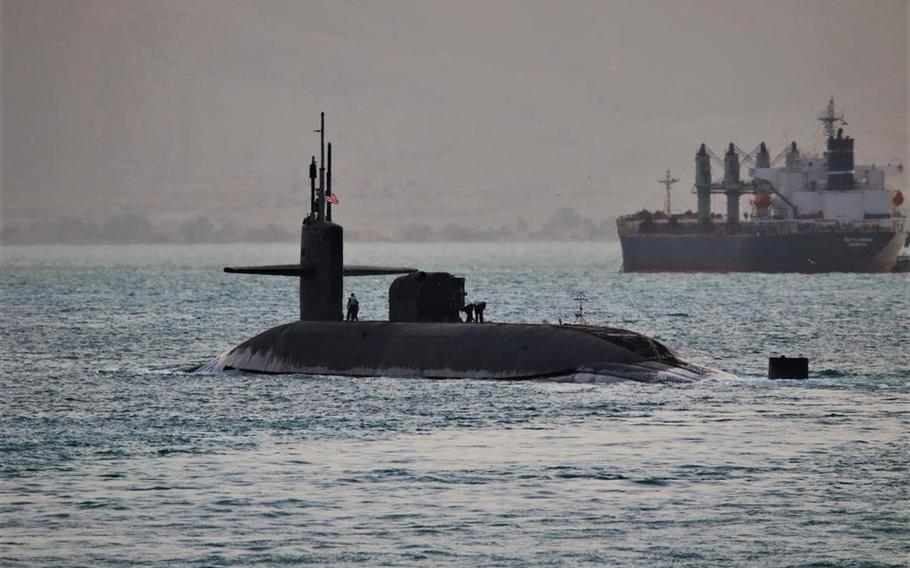
Guided-missile submarine USS Florida transits the Suez Canal en route to the Red Sea, April 7, 2023. (Elliot Schaudt/U.S. Navy)
The U.S. Navy released a photo Saturday of a guided-missile submarine operating in the Middle East, a show of force that comes amid growing harassment of U.S. troops in Syria and attacks on U.S. bases by Iran-backed militants.
USS Florida, an Ohio-class submarine that carries 154 Tomahawk cruise missiles, entered the region Thursday and began transiting the Suez Canal the following day, Cmdr. Timothy Hawkins, a spokesman for U.S. Naval Forces Central Command/U.S. 5th Fleet, said in a statement.
The vessel “is deployed to U.S. 5th Fleet to help ensure regional maritime security and stability," Hawkins said.
The fleet’s area of responsibility includes the Gulf of Oman, the Persian Gulf, the Red Sea and parts of the Indian Ocean.
The Navy doesn’t typically choose to reveal the locations of its submarines while they’re at sea. The photo, taken Friday, was released through the Defense Department’s media website.
The show of force follows the repositioning of the George H.W. Bush Carrier Strike Group in the Mediterranean Sea closer to the Middle East, as well as U.S. airstrikes on facilities in Syria used by groups affiliated with Iran’s Islamic Revolutionary Guard Corps.
Those actions came after a drone attack in Syria last month that killed a U.S. contractor and injured at least five service members and another contractor. Four of those troops have been diagnosed with traumatic brain injuries, CNN reported March 30.
The U.S. also is concerned about potential threats to merchant vessels in regional waters, according to an official familiar with the matter.
Analysts say that Iran is likely to continue its proxy attacks.
Growing relationships with Russia and China, each reliant on Iranian gas, and restored ties with Saudi Arabia could be bolstering Iran’s belligerence, according to regional analysts.
The attacks are “going to increase until something comes to a head,” said Steph Shample, a nonresident scholar with The Middle East Institute, a Washington D.C.-based think-tank. “The only thing that is going to make Iran calm down and simmer down would be losing its allies and losing its support system.”
In all, Iranian-backed militia forces have attacked U.S. troops in Iraq and Syria 83 times in the last two years, Defense Secretary Lloyd Austin told the Senate Armed Services Committee last month.
There have been four major U.S. responses, Austin said.
The military is careful to ensure “we are going after the element that is responsible for whatever that activity is,” he said.
Stronger but nuanced actions could make Iran hit the pause button, said Michael Pregent, a former U.S. military intelligence officer.
Appropriate responses include the targeting of the IRGC’s Quds Force, the group in charge of orchestrating the attacks on U.S. positions through proxy militia groups, he said.
The Quds Force is the group “we need to be targeting and targeting them very harshly over time, and that is exactly what we plan on doing,” said Chairman of the Joint Chiefs of Staff Gen. Mark Milley, speaking during the same Armed Services Committee meeting as Austin.
Still, Iran-backed militias countered retaliatory U.S. airstrikes by launching 10 rockets on March 24 at a base in northeastern Syria. The U.S. did not respond to that attack, Austin said.
Accordingly, Pregent isn’t confident the U.S. will take a tougher approach, which could include targeting the IRGC’s ships, advisers or commanders on the ground in Syria or Iraq.
Iran understands U.S. reticence and, accordingly, feels confident escalating the attacks, said Pregent, now a senior fellow with the Washington D.C.-based Hudson Institute.
“We need to have a policy where we actually make them regret their provocations instead of reinforcing that these provocations work,” he said.